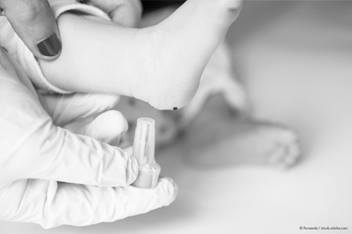Chromosome Analysis Test
Your child’s health care provider has ordered a genetic test called a chromosome (CRO-mo-soam) analysis. This test can show if your child was born with the usual number of chromosomes or if the size or structure of the chromosomes are different.
This test does not check for every possible genetic disease or give information about a specific gene.
Chromosomes
The body is made up of billions of cells. Inside each cell are chromosomes. Chromosomes are structures that contain thousands of genes (Picture 1).
Genes tell the body how to grow and work. Genes also hold information about traits, such as our eye and hair color and blood type.
Each cell normally has 46 chromosomes that are arranged in 23 pairs. To form the pair, one chromosome comes from the mother and the other comes from the father. In the first 22 pairs, female and male chromosomes should match up in size and shape.
The last chromosome pair is called the sex chromosome because it tells what genetic gender a person is born with. A female has two copies of the X chromosome. A male has one X chromosome and one Y chromosome (Picture 2).
What This Test Can Tell

The chromosome analysis can tell if there are:
- more or less than 46 chromosomes
- a large missing (deleted) piece of a chromosome
- a large extra (duplication) piece of a chromosome
- one or more of the chromosomes that have an unusual structure. A piece of one chromosome can be attached to another chromosome (translocation) or can be upside down (inversion).
Birth defects, delays in development or other health problems can happen if there is a change in the number or structure of the chromosomes. When a person has an unusual chromosome structure, there can be an increased risk of miscarriage or birth defects in future pregnancies.
How the Test is Done
- Chromosome analysis is usually done on a blood sample. Sometimes amniotic fluid (fluid from inside the womb) or tissue (like skin) is tested.
- A laboratory (lab) will first grow the cells in special chemicals. Once enough cells grow, the chromosomes in the cells are stained with a dye to give them a striped or banded look. This helps to tell them apart when viewed under a microscope.
- The technician looks at the chromosomes under a microscope first, then photographs all the chromosomes in one cell with a camera attached to the microscope. A computer imaging program is used to pair and arrange the chromosomes by size (Picture 2). The picture of the chromosomes is called a karyotype (CARE-ee-o-type).
- Results will be available to patients in 4 weeks.
After the Test
Your health care provider will talk to you about the test results. Sometimes more genetic testing is ordered. If you have any questions, please ask the provider who ordered this test or your genetic counselor.
For directions to the nearest Laboratory Service Center, call (800) 934-6575 or visit our website at: NationwideChildrens.org/Lab.
Chromosome Analysis Test (PDF)
HH-III-49 ©1980, Revised 2021, Nationwide Children’s Hospital



